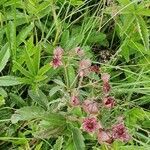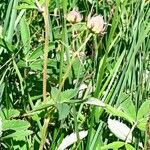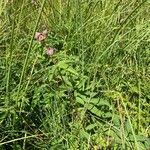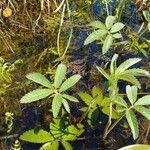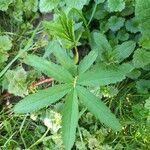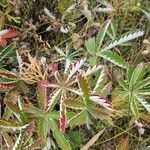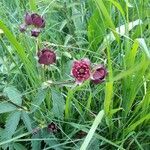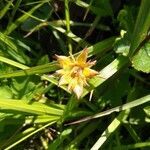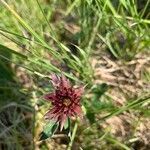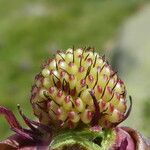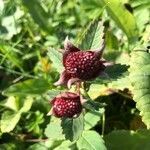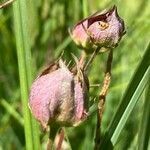Herbs perennial, 20–30 cm tall. Rhizome branched, dark brown, long, woody. Flowering stems ascending, branched near base, pale red-brown, hollow, glabrous in lower part, hairy in upper part. Radical leaves 6–16 cm including petiole; stipules mostly adnate to petiole, membranous; petiole 2.5–12 cm; leaf blade imparipinnate, 5–7-foliolate; upper cauline leaves: stipules ovate, foliaceous, apex often serrate; leaf blade 3-foliolate; leaflets sessile or subsessile, adaxially dark green, elliptic or oblong, 4–7 × 1.2–3 cm, abaxially villous, adaxially glabrous or slightly appressed pilose, base cuneate, margin proximally entire, distally sharply serrate, apex obtuse or acute. Inflorescence terminal or axillary, cymose, 1-to several flowered; peduncle and pedicels pilose and glandular hairy. Flowers 1–1.5 cm in diam.; pedicel 1–1.5 cm; bracts conic, 3–5 mm. Hypanthium saucer-shaped, abaxially pilose. Sepals spreading, dark purple, triangular-ovate, 0.7–1.8 cm, both surfaces pilose, apex acuminate; epicalyx segments lanceolate to linear, 4–9 mm, abaxially pilose, apex acute or acuminate. Petals dark purple, ovate-lanceolate, 3–8 mm, shorter than sepals, apex acuminate. Stamens 15–25, shorter than the petals; filaments and anthers dark purple. Ovary dark purple, ovoid, glabrous; style filiform. Achenes numerous, yellow-brown, compressed ovoid, ca. 1 mm, glabrous. Fl. May–Aug, fr. Jul–Oct.
More
Stems 1–10(–18) dm. Leaves: petiole 5–10(–15) cm; leaflets usually abaxially glaucous, adaxially green, sometimes silvery-silky, often aging reddish, 1.5–10(–12) × (0.8–)1–5 cm. Pedicels 5–25(–30) mm. Flowers: epicalyx bractlets narrowly lanceolate to lanceolate, 2–7(–9) mm, usually equal to or shorter than sepals; sepals greenish purple adaxially, (5–)7–12(–14) mm, apex acuminate; petals 2.5–6(–8) mm; anthers dark purple, 0.8–1.2 mm, connectives thickened, greenish purple to purple; styles 0.9–2 mm. 2n = 28, (35)36, 42, (60, 62, 63)64.
A herb. It keeps growing from year to year. It grows 20-30 cm tall. It has a branched rhizome. It is long, dark brown and woody. The leaves near the ground are 6-16 cm long. The leaves on the stems have 5-7 leaflets with one at the end.
